Posted by: Northwest Eye in General on October 15, 2025
Overview
If you are a cataract patient, it’s important to be aware of high eye pressure symptoms, such as:
- Blurred vision
- Eye pain
- Halos around lights
- Headaches
These symptoms can indicate serious underlying conditions, and we understand how concerning that can be. Recognizing these signs is crucial, as seeking prompt medical attention can help prevent irreversible vision loss. Remember, timely intervention is essential for effectively managing your eye health, and we are here to help you through this process.
Introduction
Elevated eye pressure is a silent threat that can significantly impact vision, especially for individuals grappling with cataracts. We understand that this can be a source of concern. Recognizing the symptoms associated with high eye pressure is crucial, as timely recognition can lead to effective intervention and prevent irreversible damage. It’s common to feel overwhelmed when faced with signs like blurred vision, eye pain, or sudden changes in sight. This article delves into the ten critical symptoms every cataract patient should be aware of, empowering you to take proactive steps towards safeguarding your eye health.
Northwest Eye: Expert Care for High Eye Pressure Symptoms
At Northwest Eye, we understand the importance of educating individuals and providing thorough care, especially for those showing high eye pressure symptoms. With over 50 years of experience, our dedicated team of skilled ophthalmic surgeons is here to diagnose and treat conditions that can lead to . Recognizing the high eye pressure symptoms is essential for prompt action and effective care, particularly for cataract patients who often face a higher risk.
Elevated eye tension can manifest through various high eye pressure symptoms, such as:
- Eyeaches
- Nausea
- Blurred vision
It’s crucial not to ignore these signs, as they may indicate high eye pressure symptoms, which can result in permanent vision loss if left untreated. Regular eye examinations are vital, as they can detect increased tension early, allowing for timely management.
Research shows that cataract surgery can initially raise eye tension due to retained viscoelastic and proteins released during the procedure, which can slow fluid drainage. However, with appropriate follow-up care and interventions, such as prescribed eye drops, individuals can manage their eye pressure effectively.
Patient education is a key component of this process. By understanding the signs and the importance of consistent monitoring, individuals can take proactive steps to protect their eyesight. We are committed to equipping individuals with the information they need, ensuring they are knowledgeable about their eye health and the necessary actions to take if they notice concerning signs.
In summary, recognizing high eye pressure symptoms is crucial for cataract patients. At Northwest Eye, we are dedicated to providing the expert care and knowledge you need to navigate these challenges with confidence.
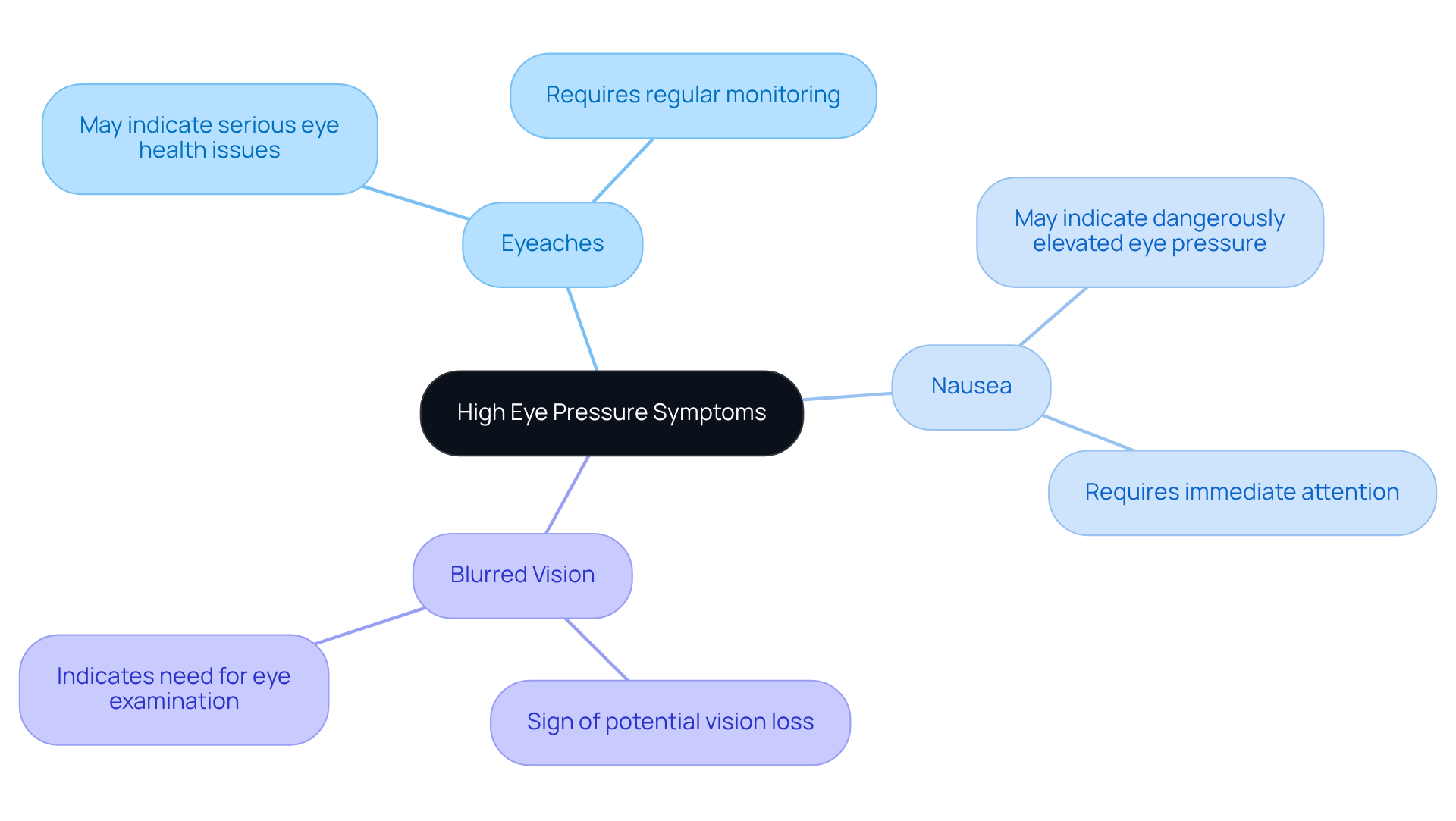
Blurred Vision: A Key Indicator of High Eye Pressure
Blurred vision can often be one of the early signs of increased eye tension, which is particularly significant for those living with cataracts. Many individuals share their experiences of encountering blurry or reduced visual clarity, which may suggest that high eye pressure symptoms are affecting the optic nerve. We understand that this can be concerning, and it’s essential to to prevent further complications.
Research indicates that around 50% of individuals with cataracts experience blurred vision, underscoring its importance in eye health. Ophthalmologists emphasize that managing high eye pressure symptoms is crucial, as untreated conditions can lead to permanent damage. For instance, individuals with pigment dispersion syndrome may notice halos or blurred vision after physical activities, highlighting the necessity for regular eye check-ups.
Understanding the connection between cataracts and blurred vision is vital for timely intervention and maintaining overall eye health. We are here to help you through this process, ensuring you receive the care and support you need.
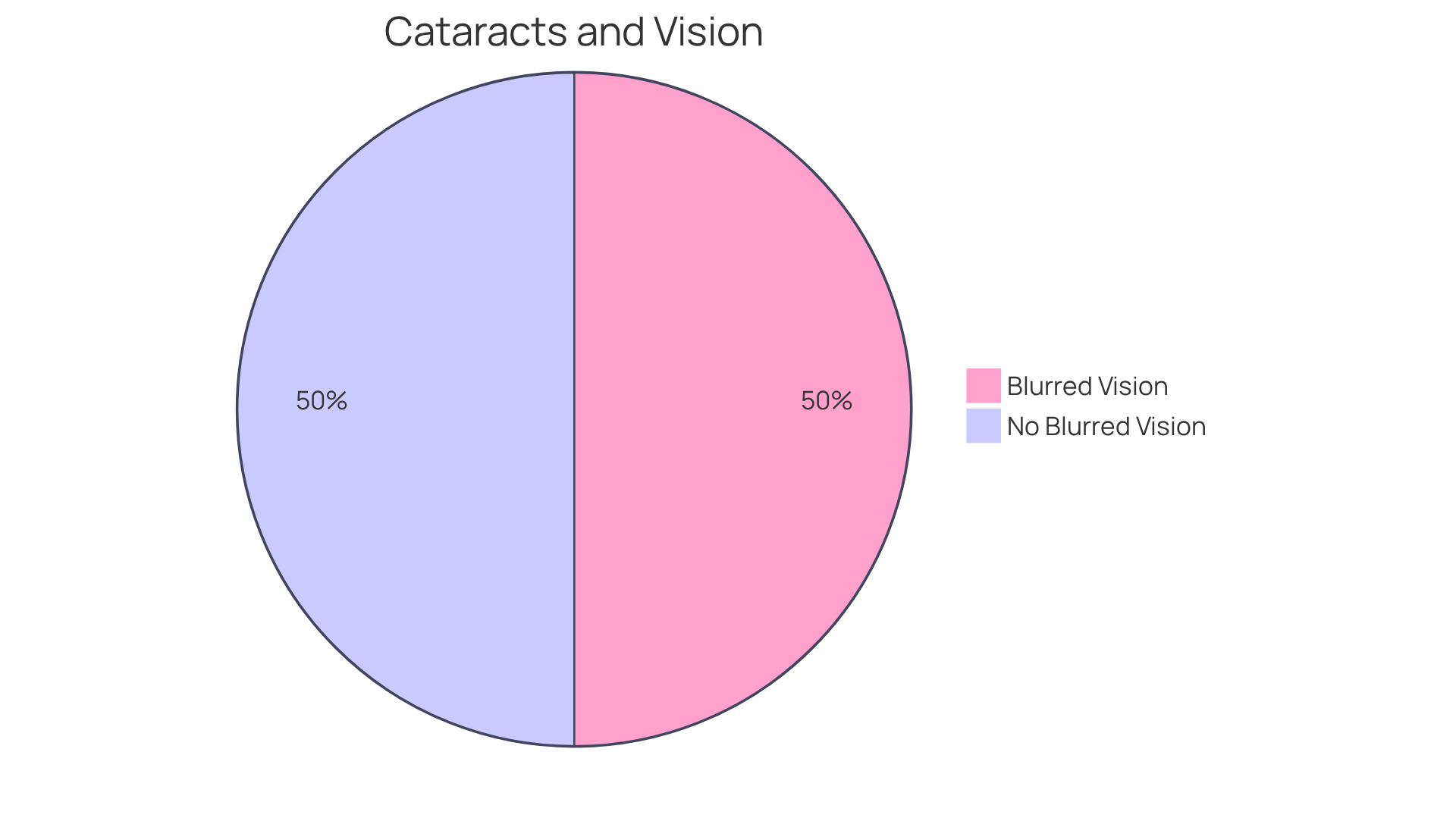
Eye Pain: A Warning Sign of Elevated Eye Pressure
Eye discomfort can be a concerning sign, often signaling high eye pressure symptoms that cataract patients must recognize. This discomfort might manifest as a dull ache or sharp pain, frequently accompanied by redness or swelling. We understand that many individuals with glaucoma—about 50%—may not even be aware of their condition, underscoring the importance of being vigilant about eye pain. If you experience persistent discomfort, it’s crucial to seek medical advice promptly, as it could indicate serious underlying issues that require timely intervention. Recognizing that high eye pressure symptoms can lead to permanent vision impairment highlights the importance of addressing these concerns quickly.
If you are experiencing eye pain, we encourage you to learn about routine eye care and consider scheduling an appointment with a Northwest Eye doctor. Discussing your symptoms can help explore potential treatment options, including advanced solutions like the Light Adjustable Lens (LAL). This innovative technology allows for , ensuring that your vision is tailored to your lifestyle needs. Remember, we are here to help you through this process.
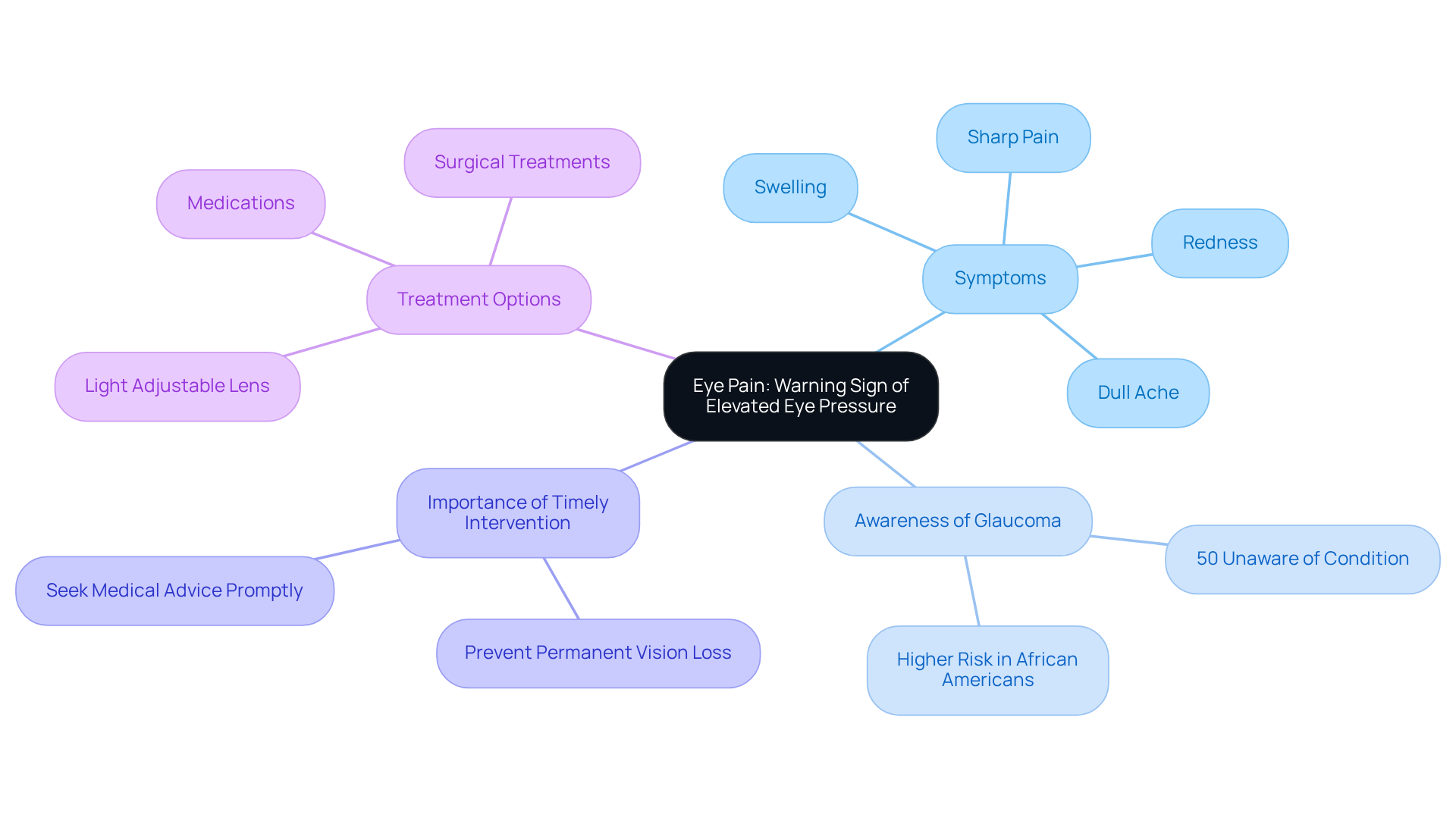
Headaches: Potential Symptoms Linked to High Eye Pressure
Headaches, especially those accompanied by a feeling of tension around the eyes, can be concerning. We understand that many patients experience these headaches with increased frequency or intensity, which may signal potential eye health issues. Research indicates that approximately 50 to 80 percent of individuals with open-angle glaucoma report headaches associated with high eye pressure symptoms. This connection underscores the importance of recognizing these signs, as they can prompt timely consultations with eye care professionals.
Eye care specialists emphasize that understanding the relationship between headaches and eye tension is crucial for effective management of eye concerns. For instance, Dr. Janey Wiggs notes that headaches can serve as a significant indicator, particularly for those with a history of eye problems. Many individuals share their experiences, recounting how headaches often coincide with high eye pressure symptoms. This reinforces the necessity of to monitor and address these issues effectively. Remember, we are here to help you through this process, ensuring your eye health is prioritized.
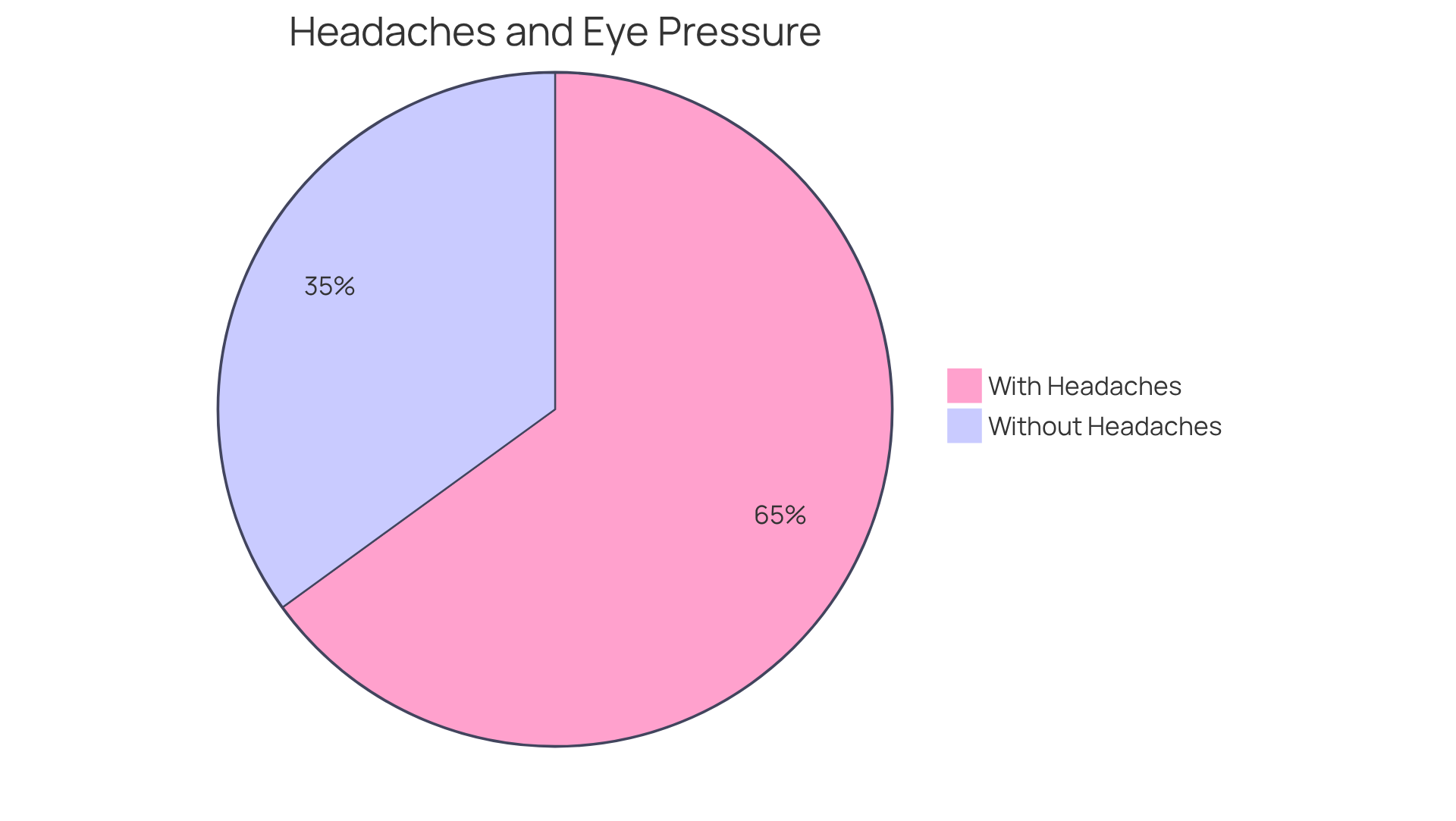
Halos Around Lights: A Visual Disturbance to Watch For
Noticing halos around lights, especially in the evening, can be concerning. It’s a significant indication of high eye pressure symptoms that cataract sufferers should be aware of. This visual disturbance often becomes more pronounced as cataracts develop, causing the lens to cloud and distort light. Halos, which are bright circles surrounding a light source, can be exacerbated by conditions such as glaucoma and high eye pressure symptoms, affecting approximately 3 million Americans aged 40 and over.
We understand that this can be alarming. Glaucoma is the leading cause of blindness among African-Americans and a leading cause of blindness in adults over 60, highlighting the severity of the condition. If you notice halos or other warning signs, like observing rainbow rings or glare, it’s important to reach out to your eye care professional promptly, as these may be high eye pressure symptoms. They can assess your eye condition and explore possible treatment alternatives.
It is recommended to have comprehensive eye exams every year after age 40, or earlier if there are risk factors or a family history of glaucoma. Prompt identification and action are essential, as unmanaged high eye pressure symptoms can lead to .
Furthermore, innovative solutions like the Light Adjustable Lens (LAL) offer personalized vision correction during cataract surgery, providing you with the best chance for life without glasses. This advanced technology allows for adjustments post-surgery, ensuring optimal visual outcomes tailored to your lifestyle. Remember, we are here to help you through this process and support you every step of the way.
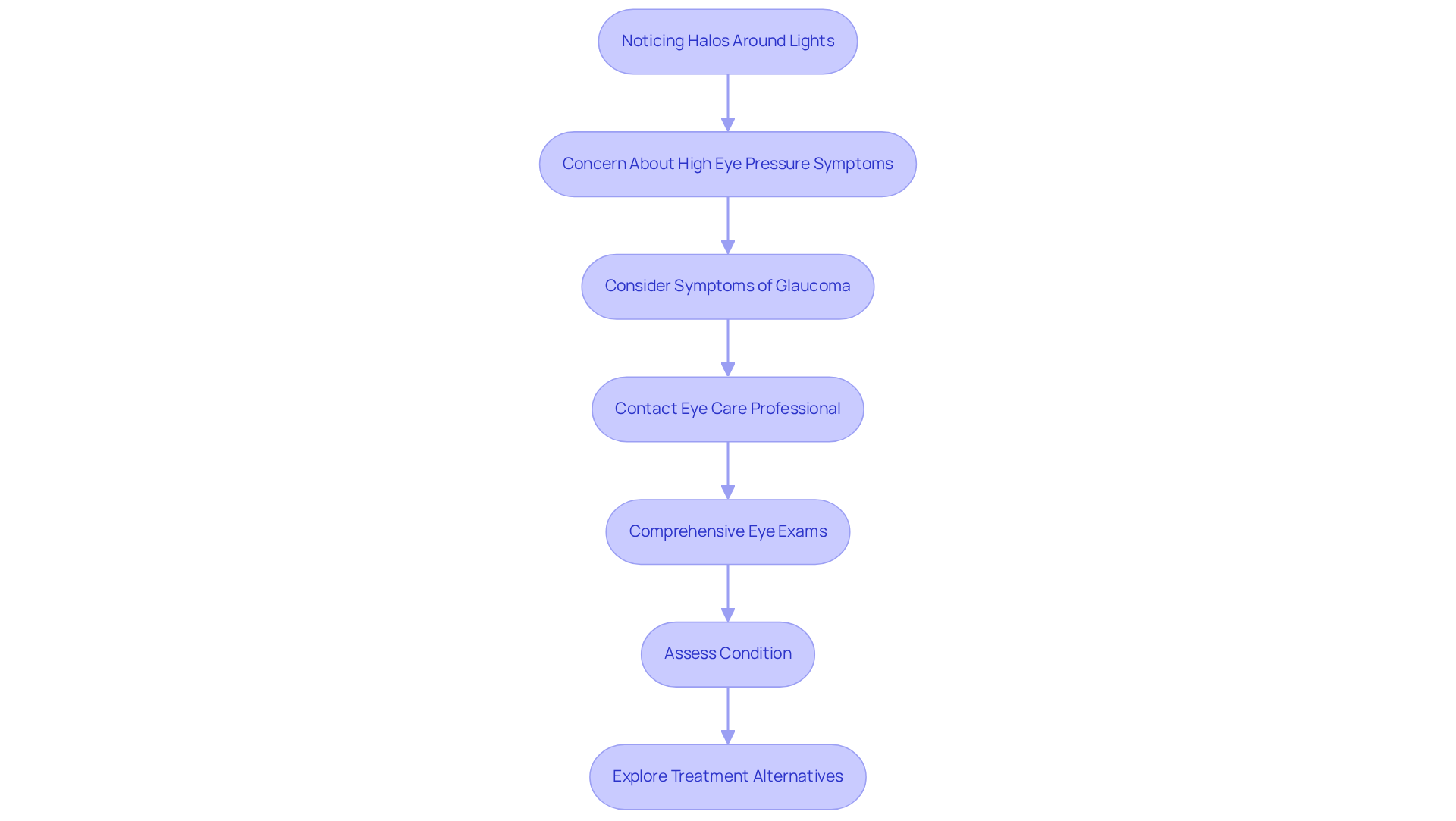
Redness in Eyes: A Symptom of Possible High Eye Pressure
Eye redness can be a significant sign of inflammation or increased tension within the eye, often accompanied by discomfort or blurred vision. We understand that experiencing can be concerning, and it’s important not to ignore this indication, as it may require further evaluation and treatment.
Recent research has shown that individuals with high ocular tension often describe high eye pressure symptoms, such as signs of eye redness, emphasizing its commonality in this group. Eye care specialists stress that although redness can arise from multiple factors, its link to high eye pressure symptoms necessitates close observation.
Disregarding ongoing redness may lead to further issues, making it crucial for you to inform your eye care provider quickly about any such signs. Remember, we are here to help you through this process.
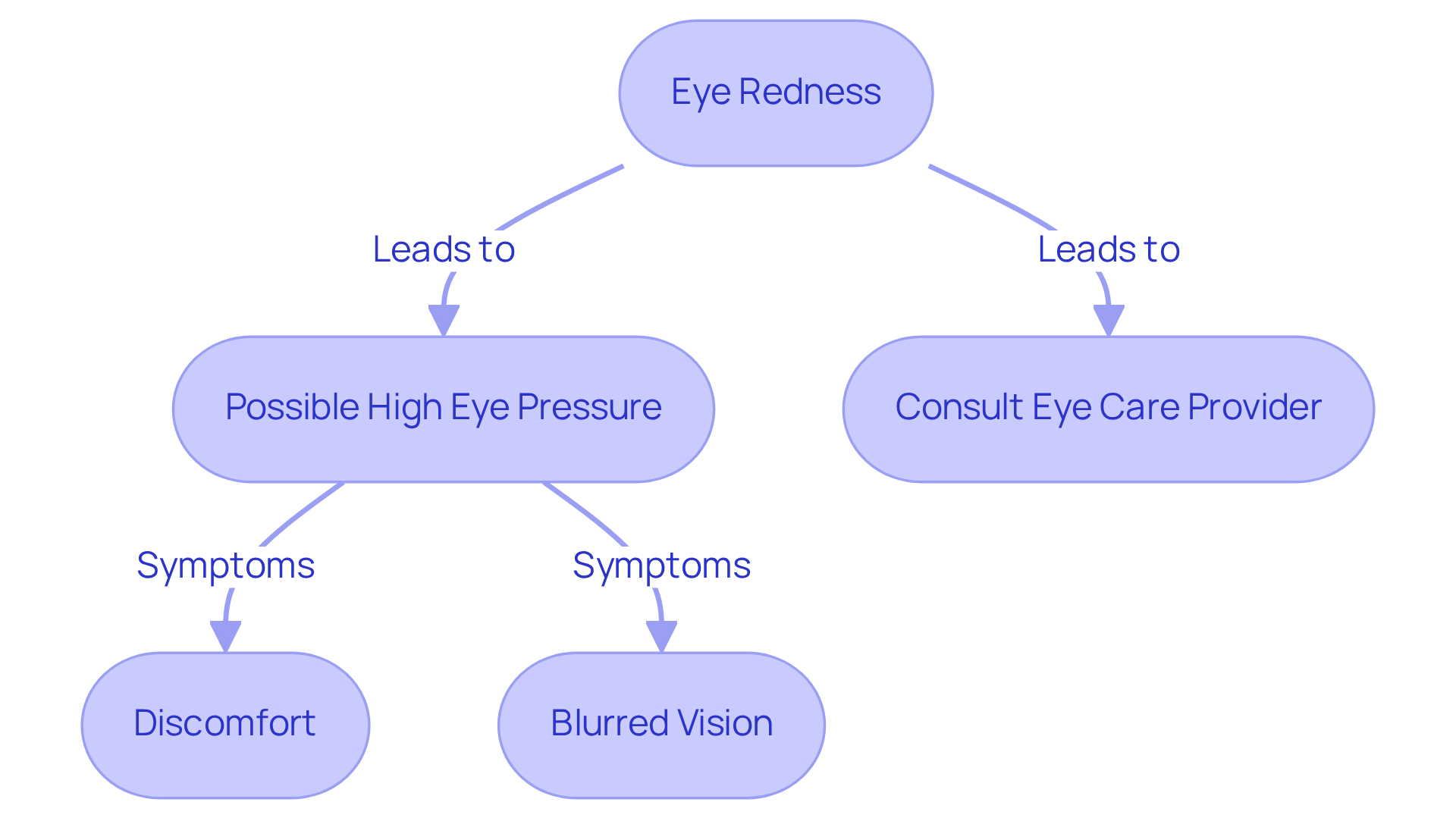
Sudden Vision Changes: An Urgent Symptom of High Eye Pressure
Sudden changes in your vision, such as loss of sight or significant blurriness, can be alarming. These are critical indicators that may suggest the presence of high eye pressure symptoms. In fact, about 50% of cataract patients report experiencing sudden vision changes. This highlights the importance of seeking . We understand that this can be a distressing experience, but timely intervention is crucial. It can prevent irreversible damage to the optic nerve and help preserve your vision.
Ophthalmologists emphasize the importance of recognizing the high eye pressure symptoms. As one expert wisely noted, ‘Timely detection and suitable treatment are essential to enhance the outlook for individuals with acute angle-closure glaucoma.’ If you notice any concerning signs, please don’t hesitate to reach out for immediate assistance. Delays can lead to serious outcomes, including permanent vision loss.
If you are experiencing sudden changes in your vision, we are here to help you through this process. Contact your eye care provider right away or visit the nearest emergency room. Remember, you are not alone in this; seeking help is a vital step towards ensuring your eye health.
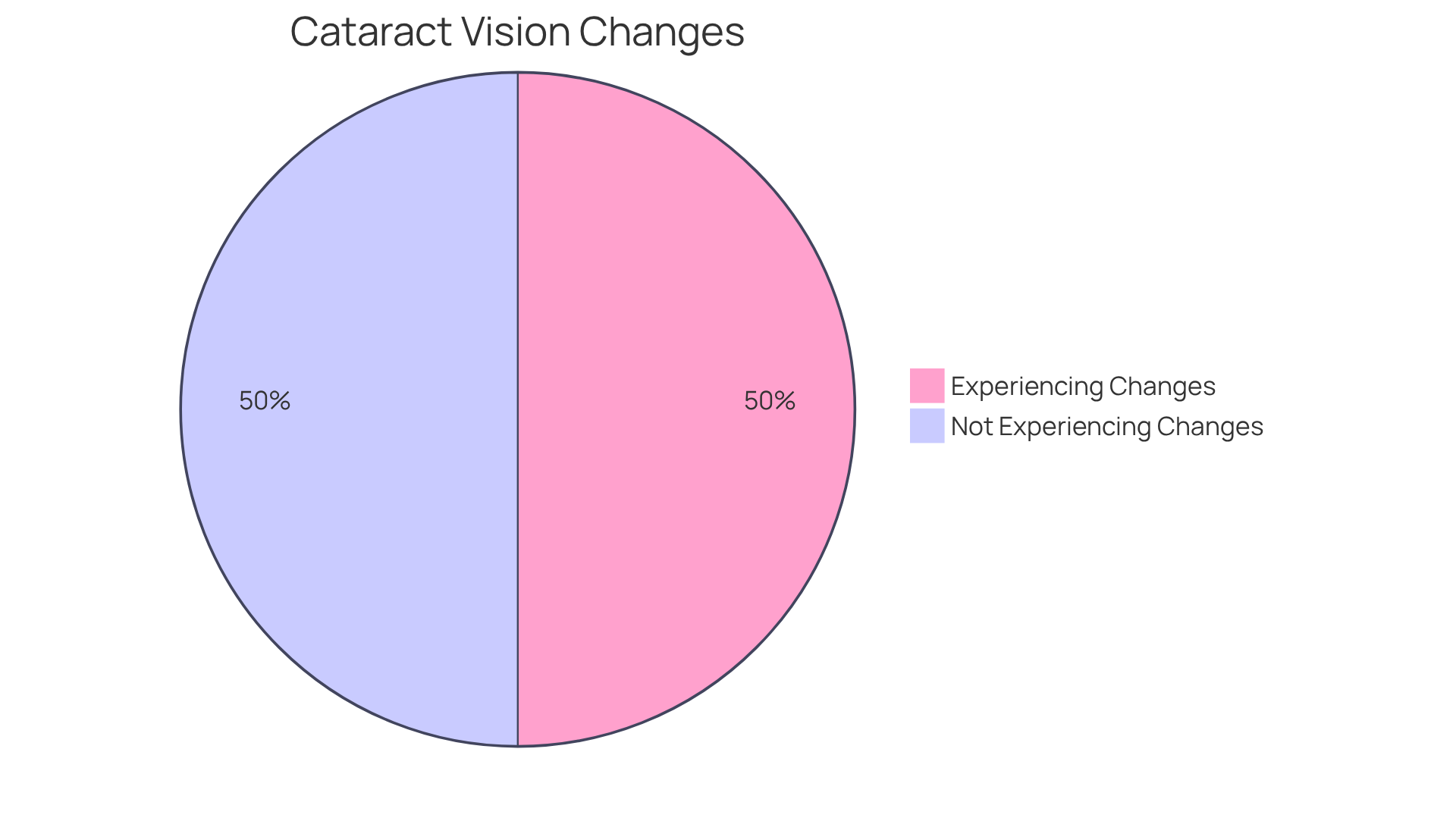
Nausea: An Uncommon Symptom Associated with High Eye Pressure
Nausea, while not a common indication, can occur in patients who are experiencing high eye pressure symptoms due to significantly elevated intraocular pressure (IOP). We understand that this can be concerning, especially when it is associated with other high eye pressure symptoms like headaches or eye pain, creating a complex clinical picture. It’s important to know that approximately 3 million individuals in the U.S. are affected by glaucoma, a condition often linked to high IOP.
Eye care professionals emphasize the importance of recognizing high eye pressure symptoms, including nausea and visual disturbances. This combination may signal a need for . If you are feeling nausea along with these signs, it’s common to feel anxious about what this might mean. We encourage you to quickly seek advice from your eye care professional. They can help evaluate your situation and discuss possible treatment alternatives. Remember, you are not alone in this, and we are here to help you through this process.
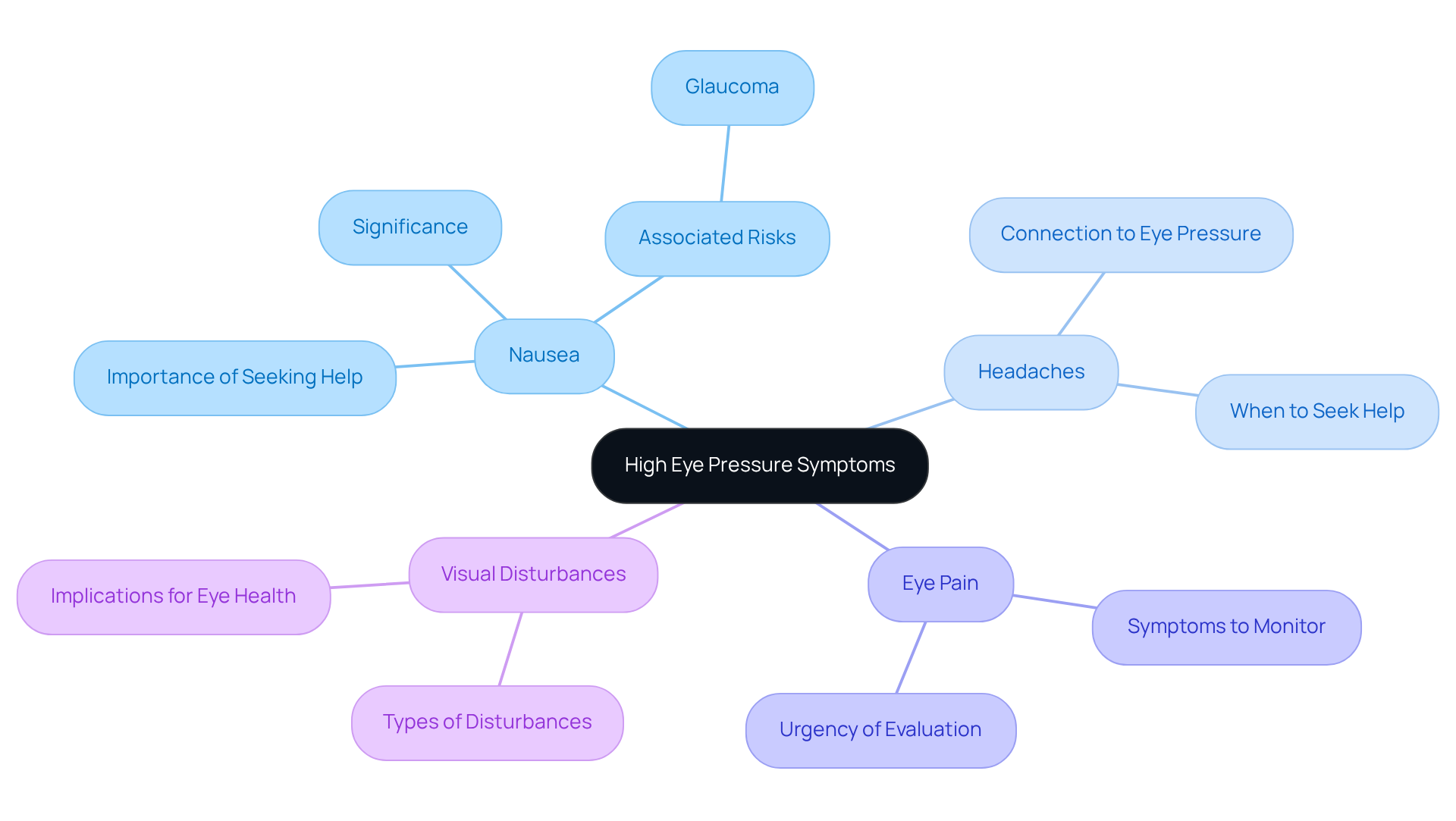
Sensitivity to Light: A Symptom of Elevated Eye Pressure
Heightened sensitivity to light, known as photophobia, is an important sign that can be linked to high eye pressure symptoms. We understand that many patients experience discomfort in bright environments, often finding glare particularly distressing. For example, individuals with cataracts frequently report heightened light sensitivity, which can profoundly affect their daily activities and overall quality of life. Research indicates that up to 80% of individuals with blepharospasm, a condition associated with increased eye tension, experience . This underscores the importance of recognizing this sign.
Ophthalmologists stress the critical nature of photophobia as an indicator of underlying conditions such as glaucoma, which is often linked to high eye pressure symptoms, or cataracts. One expert emphasizes, “Photophobia can be a critical indicator of underlying conditions such as glaucoma or cataracts, and it warrants prompt evaluation by an eye care provider.” Routine eye examinations are vital, as many individuals may not be aware of their condition, which could include high eye pressure symptoms; approximately half of those with glaucoma remain undiagnosed. Additionally, it is noteworthy that 25% of adults feel that photophobia significantly impacts their quality of life, highlighting the urgent need for awareness and proactive management.
Addressing increased eye tension through appropriate therapies can alleviate discomfort and enhance overall well-being. It is essential for individuals to communicate any changes in their light sensitivity to their eye specialist, as we are here to help you through this process.
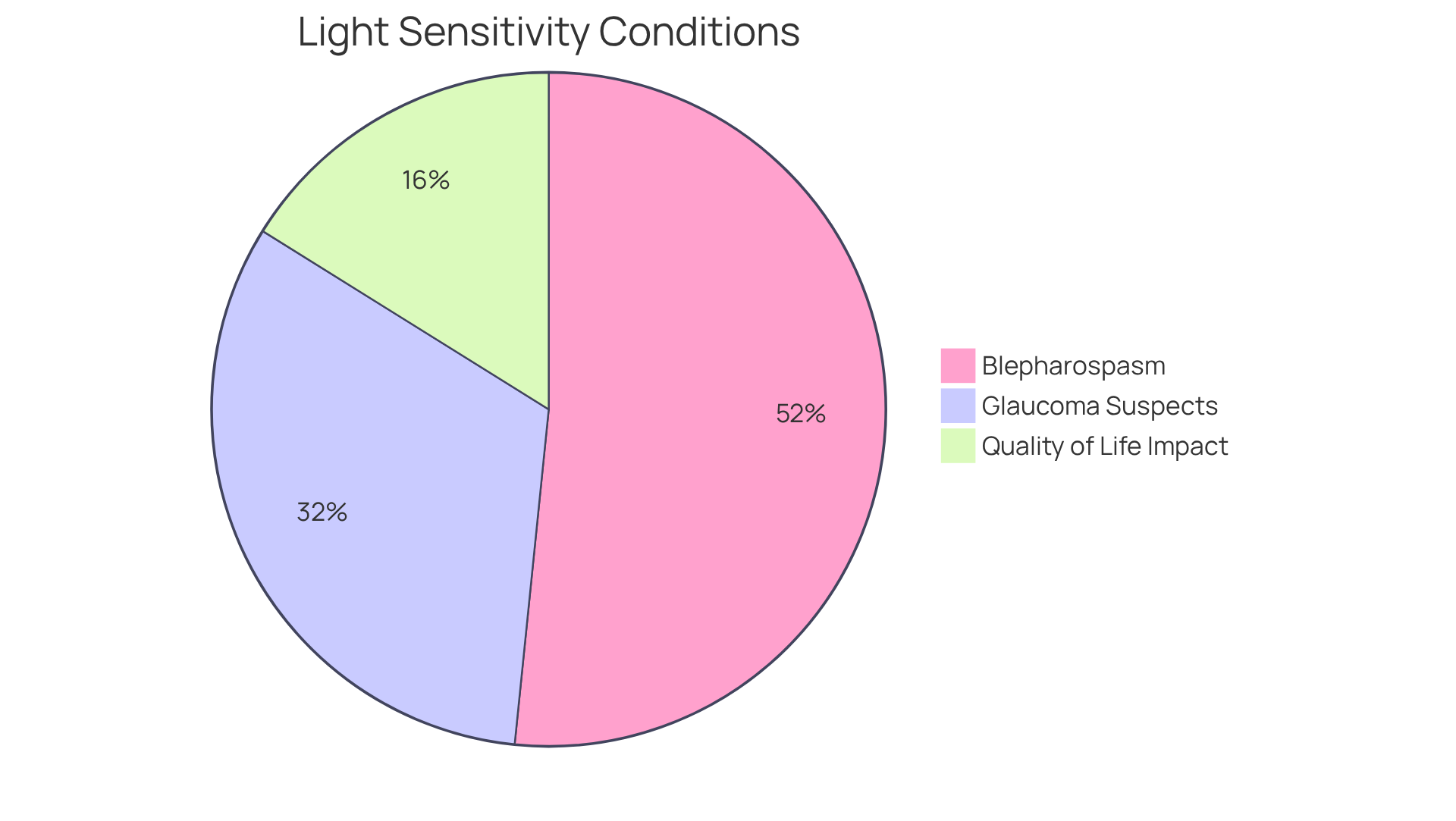
Seek Medical Advice: Importance of Addressing High Eye Pressure Symptoms
Identifying and addressing high eye pressure symptoms is vital for maintaining your eye health, especially for those living with cataracts. We understand that experiencing symptoms such as:
- Blurred vision
- Halos around lights
- Glare
may indicate high eye pressure symptoms, which can be concerning. Blurred vision might stem from refractive errors such as nearsightedness or astigmatism, or from conditions like cataracts and diabetic retinopathy. Halos are those bright circles that can surround light sources, while glare refers to excessive brightness that may disrupt your vision, particularly when driving at night. If you notice any high eye pressure symptoms, please seek medical advice promptly. Early intervention is key to preventing complications and ensuring the best outcomes for your vision.
At Northwest Eye, we are here to support you with innovative solutions like the Light Adjustable Lens (LAL), which offers personalized vision correction during cataract surgery. This approach enhances your visual experience and improves your quality of life.
Conclusion
Recognizing the symptoms of high eye pressure is essential for cataract patients. We understand that these indicators can be critical for maintaining your eye health and preventing serious complications. It’s important to be aware of symptoms such as:
- Blurred vision
- Eye pain
- Headaches
- Halos around lights
These warrant immediate attention from eye care professionals. By understanding these signs, you can take proactive steps to safeguard your vision and overall well-being.
Throughout this discussion, we have highlighted key symptoms, including the importance of regular eye examinations to detect elevated eye pressure early. It’s common to feel uncertain about what to look for, but knowing the connection between high eye pressure and symptoms like nausea and sensitivity to light reinforces the need for comprehensive monitoring and management.
Moreover, advancements in treatment options, like the Light Adjustable Lens (LAL), offer promising solutions for cataract patients, enhancing your visual outcomes.
Ultimately, the message is clear: addressing high eye pressure symptoms promptly is vital for preserving your vision and quality of life. If you experience any concerning signs, please do not hesitate to seek medical advice. By prioritizing your eye health and staying informed, you can navigate your journey with confidence, ensuring that you receive the expert care you deserve.
Frequently Asked Questions
What are the symptoms of high eye pressure?
Symptoms of high eye pressure can include eyeaches, nausea, and blurred vision. It is important not to ignore these signs, as they may indicate serious eye health issues.
Why is it important to recognize high eye pressure symptoms?
Recognizing high eye pressure symptoms is crucial because untreated conditions can lead to permanent vision loss. Early detection through regular eye examinations allows for timely management.
How can cataract surgery affect eye pressure?
Cataract surgery can initially raise eye pressure due to retained viscoelastic and proteins released during the procedure, which can slow fluid drainage. However, with proper follow-up care and prescribed eye drops, individuals can effectively manage their eye pressure.
How common is blurred vision among individuals with cataracts?
Research indicates that around 50% of individuals with cataracts experience blurred vision, making it a significant indicator of potential high eye pressure.
What should I do if I experience eye pain?
If you experience eye pain, it is important to seek medical advice promptly, as it may indicate serious underlying issues related to high eye pressure. Discussing your symptoms with an eye care professional can help explore treatment options.
What technology is available for managing vision after cataract surgery?
The Light Adjustable Lens (LAL) is an innovative technology that allows for adjustments to be made after cataract surgery, ensuring that the vision is tailored to the individual’s lifestyle needs.
How does Northwest Eye support individuals experiencing high eye pressure symptoms?
Northwest Eye is committed to providing expert care and education to individuals showing high eye pressure symptoms. They offer thorough assessments, treatment options, and patient education to help individuals manage their eye health effectively.






